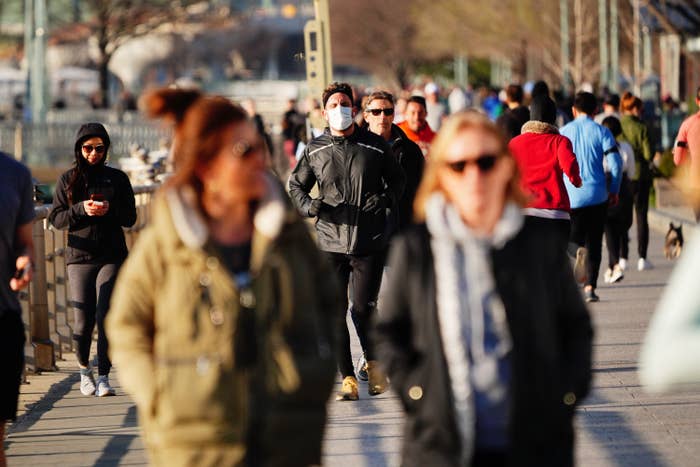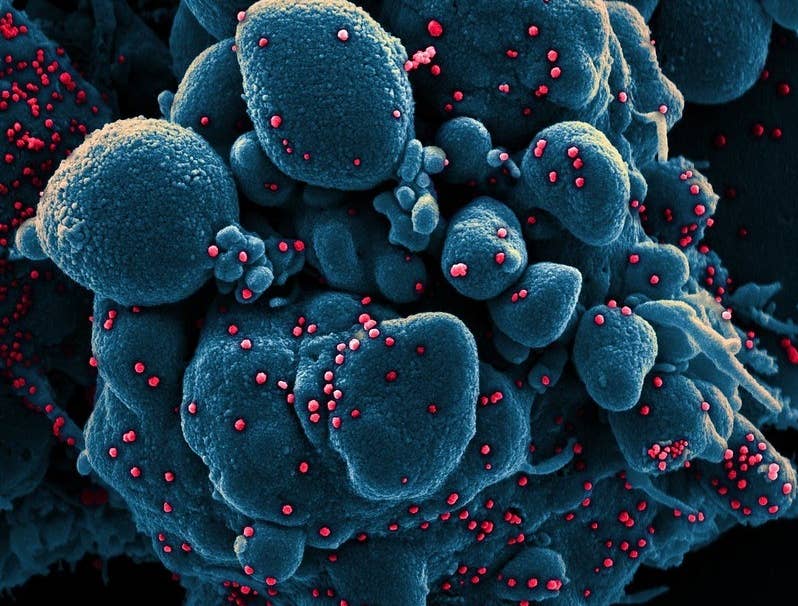“Silent Carriers” Are Helping Spread The Coronavirus. Here’s What We Know About Them.
People with no COVID-19 symptoms may be spreading the disease — but big questions remain about how much they are driving the pandemic.
Stephanie M. LeeBuzzFeed News Reporter April 2, 2020

Nurphoto / Getty Images
People walk in a New York City park despite social distancing orders, March 26.
Fever, a dry cough, fatigue: By now, these have become the telltale signs of COVID-19. But can it be unwittingly spread by people with no symptoms?
In late January and early February, when the disease had begun to spread outside China, leading health officials, including the World Health Organization, told the public that transmission from asymptomatic people was likely “rare,” based on information available at the time. “In all the history of respiratory-borne viruses of any type, asymptomatic transmission has never been the driver of outbreaks,” Dr. Anthony Fauci, director of the National Institute of Allergy and Infectious Diseases, said on Jan. 28.
Those assessments were based on early data out of China, where the virus originated in late December. A few months later, as the coronavirus has afflicted more than 1 million people worldwide and killed 51,000 of them, scientists know a lot more about how the virus spreads. And an emerging body of data suggests that there are probably a significant number of infected people who don’t have symptoms but are likely to be transmitting the virus. Since they may not know that they’re sick, they may be taking fewer precautions than people with symptoms.
Researchers still don’t know how common these cases are or how much they are driving the pandemic. On Monday, the director of the CDC told NPR that the number of asymptomatic individuals “may be as many as 25%.”
Here’s what we know so far about these so-called silent carriers.
1. First, it’s important to keep in mind that “asymptomatic” is different from “presymptomatic.”
Being presymptomatic means you’ve been infected and don’t feel any symptoms at the time you get tested, but will develop them later on. In contrast, asymptomatic people never have any symptoms during the course of their infections at all.
That difference matters for the scientists who are racing to identify and count cases to study the spread of the virus. If you’re truly asymptomatic, you’re probably not going to get tested and would therefore never be counted by the health care system. But you may still be contributing to the virus’s spread.
Alternatively, suppose you are symptom-free when you test positive, only to later develop a fever and cough that you don’t report to your doctor. You might be mistakenly counted as asymptomatic rather than presymptomatic.
“Previously we had commonly used asymptomatic to include both groups so it's tough to break out of that thinking and lexicon,” Tara Smith, an epidemiologist at Kent State University, said by email. “But I think this pandemic has shown that there may be nuance between those who are not YET symptomatic and those who might NEVER show symptoms, and that seems to be important here.”
To Jeffrey Shaman, an infectious disease expert at Columbia University, the simpler and more important distinction is between “documented” versus “undocumented” cases — the latter being all infected people who aren’t diagnosed. Those could include a person who is very sick but “hates to go to the hospital or see a doctor and toughs it out at home,” he told BuzzFeed News.
It’s more likely that a lot of these undocumented COVID-19 cases have symptoms mild enough that they don’t feel the need to see a doctor, but are walking around in the world anyway, he said.
The slight differences in these terms matter. “They’re not all the same thing but are getting conflated,” Smith said.

Carl Court / Getty Images
2. Estimates for how many “silent carriers” there are vary. For asymptomatic cases, estimates range from 18% to 30% of all infections.
It’s tough to quantify the number of asymptomatic people, because they’re unlikely to seek testing on their own. But the coronavirus outbreak on the Diamond Princess cruise ship gave researchers a unique chance to study this — even if it was a nightmare for the 3,700 passengers and crew members trapped off the coast of Japan.
Held under quarantine over two weeks in February, many of the people on board were repeatedly tested and their symptoms, or lack thereof, were tracked. CDC researchers found that 46.5% of infected people did not have symptoms at the time of testing. Many eventually did develop symptoms, but statistical models suggest that 18% of infected cases remained asymptomatic.
One caveat is that the passengers were older than the general population. Elderly people are more likely to be severely affected or killed by COVID-19, while younger people are more likely to develop mild symptoms.
Because of the skewed demographics, Gerardo Chowell, a Georgia State University mathematical epidemiologist who led a study about asymptomatic cases aboard the Diamond Princess last month, thinks the true number of asymptomatic people in the world is around 30% or 40%. “We know there’s a substantial fraction of asymptomatic” cases, he told BuzzFeed News.
Other researchers have produced estimates in this ballpark. One recent report said 29%, but was based only on a group of two dozen people in China. Another reported 30% of COVID-19 patients may not have symptoms, based on screenings of 565 Japanese citizens evacuated out of Wuhan in February.
CDC director Robert Redfield offered up yet another percentage this week, telling NPR, “One of the [pieces of] information that we have pretty much confirmed now is that a significant number of individuals that are infected actually remain asymptomatic. That may be as many as 25%.” He did not cite what that figure was based on.
Part of why it has taken a while for scientists to realize the outsize role that people without symptoms may play in spreading the disease may be because of how the initial data out of China was reported.
As of Feb. 11, the Chinese Center for Disease Control and Prevention was reporting that of more than 72,000 reported cases in mainland China, about 1.2% were asymptomatic. The WHO–China joint report about the coronavirus, from mid-February, stated, “The proportion of truly asymptomatic infections is unclear but appears to be relatively rare and does not appear to be a major driver of transmission.”
But last week, the South China Morning Post reported that, according to confidential Chinese government data, more than 43,000 people in China had tested positive for the virus by the end of February “but had no immediate symptoms.” These people were not included in the government’s official tally, according to the news outlet, which suggested that these people could therefore be as high as one-third of those who test positive. Researchers told BuzzFeed News that this estimate seemed plausible.
Putting aside the presence or absence of symptoms, low testing rates, especially in the US, mean that we do not know about a large proportion of people with COVID-19.
Shaman, the Columbia infectious disease expert, thinks the proportion of undocumented cases — infected people who are not officially diagnosed — could be as high as 86% in some places, meaning that these “invisible” cases are driving the pandemic. That estimate, published last month, was based on projected activity in Wuhan in the weeks before China imposed strict travel restrictions to stem transmission.
Since the virus has spread beyond Wuhan, Shaman said, “We’re seeing increasing evidence that there’s a lot of virus out in the community, a lot of infections out there, much more so than are being confirmed.”
More precise numbers won’t be possible to determine without health-care systems that can treat and diagnose lots of patients — which may not exist in developing countries — and robust, widespread testing. The US was slow to start testing compared to countries like South Korea and still has not scaled it up to a level that public health experts say is necessary.
The most definitive testing would include running blood antibody tests on everybody, which could detect whether they ever had the virus even if they didn’t show symptoms. Singapore has been using these tests to trace infections, and the United Kingdom is preparing to roll them out as well.
TRUMP'S "INVISIBLE" ENEMY/SCOURGE/ETC.
IS ACTUALLY QUITE VISIBLE UNDER A MICROSCOPE

NIH
Colorized scanning electron micrograph of a cell (blue) infected with the coronavirus, isolated from a patient sample.
3. Presymptomatic people can transmit the virus for a few days before they have symptoms, studies suggest.
The virus’s incubation period — the time between getting infected and showing symptoms — is about five days. That’s similar to that of the coronavirus that caused SARS. (For COVID-19, virtually everyone who develops symptoms does so by day 12.)
The problem is that people seem to be unwittingly spreading the new virus before they have symptoms, research suggests, and this presymptomatic transmission is happening at a more rapid rate than it did with SARS. With COVID-19, such transmission may even be happening more frequently than transmission from those with symptoms, researchers from Japan said in a study in late February.
“This suggests that a substantial proportion of secondary transmission may occur prior to illness onset,” they wrote.
Other research also supports the idea that presymptomatic transmission can happen for a few days before symptoms kick in. On Wednesday, the CDC released data about such cases in Singapore from late January to mid-March. In these cases, a person gave the virus to someone before they themselves developed symptoms, with no evidence that the second person had been exposed to anyone else who was infected.
In cases where researchers were able to confirm the dates of exposure, transmission happened one to three days before the originally infected patient developed symptoms, according to the report.
Scientists are still figuring out exactly when someone crosses the threshold from being infected to being able to infect others. The CDC says that someone can transmit the virus up to 48 hours before symptoms develop.
4. We don’t know with certainty that asymptomatic people are spreading the virus — though they probably are.
Completely symptom-free people can still carry around substantial amounts of the virus, also known as a person’s “viral load,” evidence suggests.
For example, researchers in China recently reported on one coronavirus patient who never developed symptoms, but whose viral load was similar to that of 17 others who did have symptoms. This “suggests the transmission potential of asymptomatic or minimally symptomatic patients,” according to a preliminary report in the New England Journal of Medicine last month. There have been other individual cases of asymptomatic transmission seeming to happen, as reported by researchers in China in February.
But it still hasn’t been definitively proven that these people are giving the virus to others. Proving that would mean checking asymptomatic people to see if they were actually excreting live virus, and therefore were infectious. Antibody tests, which can be done after an infection ends, would also confirm they were truly infected. Right now, “we really don’t know if people who are truly asymptomatic can transmit or not,” said Smith of Kent State University.
5. All of this reinforces the importance of staying home as much as you can (and, some say, of wearing a mask).
The possibility that people can unknowingly spread the virus has inspired a heated debate over whether everyone should be wearing masks in public — including homemade, nonmedical ones — to help avoid getting sick as well as to prevent infecting others. The CDC currently discourages healthy people from wearing them, but is reconsidering that guidance.
How well a mask wards off infection varies depending on the setting, use, and fabric, studies show. But Chowell, among other experts, is pro-mask all the time. “We all should be wearing some sort of mask whenever you go out and have to interact with other people,” he said.
Whether you cover your face or not, it’s still important to help prevent transmission by practicing socially distancing, which means staying 6 feet away from others in public, staying home as much as possible, and avoiding crowded places, according to public health experts and the CDC’s national guidelines. In a further attempt to reduce transmission, at least 30 states are issuing shelter-in-place orders that have closed schools, offices, parks, and nonessential businesses.
Until the virus is under control, we likely won’t fully understand what role non-diagnosed cases are playing in the outbreak.
“We know we have a problem,” said Juan Gutierrez, a mathematics professor who specializes in infectious disease modeling at the University of Texas at San Antonio. “We have a hint of what could be the size of the problem. And a story will emerge many months from now when we have widespread testing in the population and we can start ascertaining, ‘Who got affected?’ and then asking people, ‘did they ever get symptoms?’”

Stephanie M. Lee is a science reporter for BuzzFeed News and is based in San Francisco.

NIH
Colorized scanning electron micrograph of a cell (blue) infected with the coronavirus, isolated from a patient sample.
3. Presymptomatic people can transmit the virus for a few days before they have symptoms, studies suggest.
The virus’s incubation period — the time between getting infected and showing symptoms — is about five days. That’s similar to that of the coronavirus that caused SARS. (For COVID-19, virtually everyone who develops symptoms does so by day 12.)
The problem is that people seem to be unwittingly spreading the new virus before they have symptoms, research suggests, and this presymptomatic transmission is happening at a more rapid rate than it did with SARS. With COVID-19, such transmission may even be happening more frequently than transmission from those with symptoms, researchers from Japan said in a study in late February.
“This suggests that a substantial proportion of secondary transmission may occur prior to illness onset,” they wrote.
Other research also supports the idea that presymptomatic transmission can happen for a few days before symptoms kick in. On Wednesday, the CDC released data about such cases in Singapore from late January to mid-March. In these cases, a person gave the virus to someone before they themselves developed symptoms, with no evidence that the second person had been exposed to anyone else who was infected.
In cases where researchers were able to confirm the dates of exposure, transmission happened one to three days before the originally infected patient developed symptoms, according to the report.
Scientists are still figuring out exactly when someone crosses the threshold from being infected to being able to infect others. The CDC says that someone can transmit the virus up to 48 hours before symptoms develop.
4. We don’t know with certainty that asymptomatic people are spreading the virus — though they probably are.
Completely symptom-free people can still carry around substantial amounts of the virus, also known as a person’s “viral load,” evidence suggests.
For example, researchers in China recently reported on one coronavirus patient who never developed symptoms, but whose viral load was similar to that of 17 others who did have symptoms. This “suggests the transmission potential of asymptomatic or minimally symptomatic patients,” according to a preliminary report in the New England Journal of Medicine last month. There have been other individual cases of asymptomatic transmission seeming to happen, as reported by researchers in China in February.
But it still hasn’t been definitively proven that these people are giving the virus to others. Proving that would mean checking asymptomatic people to see if they were actually excreting live virus, and therefore were infectious. Antibody tests, which can be done after an infection ends, would also confirm they were truly infected. Right now, “we really don’t know if people who are truly asymptomatic can transmit or not,” said Smith of Kent State University.
5. All of this reinforces the importance of staying home as much as you can (and, some say, of wearing a mask).
The possibility that people can unknowingly spread the virus has inspired a heated debate over whether everyone should be wearing masks in public — including homemade, nonmedical ones — to help avoid getting sick as well as to prevent infecting others. The CDC currently discourages healthy people from wearing them, but is reconsidering that guidance.
How well a mask wards off infection varies depending on the setting, use, and fabric, studies show. But Chowell, among other experts, is pro-mask all the time. “We all should be wearing some sort of mask whenever you go out and have to interact with other people,” he said.
Whether you cover your face or not, it’s still important to help prevent transmission by practicing socially distancing, which means staying 6 feet away from others in public, staying home as much as possible, and avoiding crowded places, according to public health experts and the CDC’s national guidelines. In a further attempt to reduce transmission, at least 30 states are issuing shelter-in-place orders that have closed schools, offices, parks, and nonessential businesses.
Until the virus is under control, we likely won’t fully understand what role non-diagnosed cases are playing in the outbreak.
“We know we have a problem,” said Juan Gutierrez, a mathematics professor who specializes in infectious disease modeling at the University of Texas at San Antonio. “We have a hint of what could be the size of the problem. And a story will emerge many months from now when we have widespread testing in the population and we can start ascertaining, ‘Who got affected?’ and then asking people, ‘did they ever get symptoms?’”
---30---

Stephanie M. Lee is a science reporter for BuzzFeed News and is based in San Francisco.
No comments:
Post a Comment